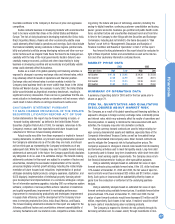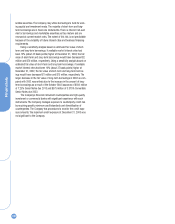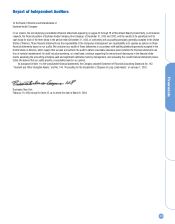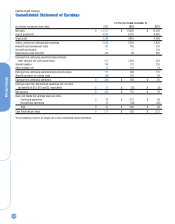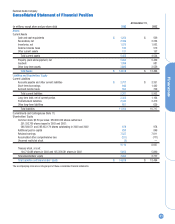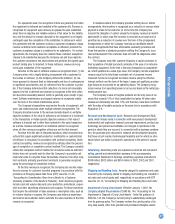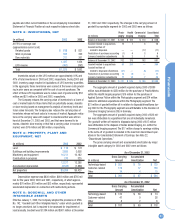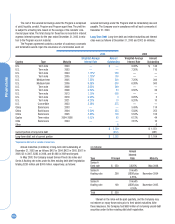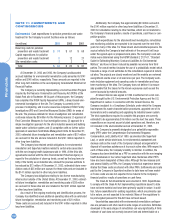Kodak 2003 Annual Report Download - page 47
Download and view the complete annual report
Please find page 47 of the 2003 Kodak annual report below. You can navigate through the pages in the report by either clicking on the pages listed below, or by using the keyword search tool below to find specific information within the annual report.
Financials
47
For equipment sales, the recognition criteria are generally met when
the equipment is delivered and installed at the customer site. Revenue is
recognized for equipment upon delivery as opposed to upon installation
when there is objective and reliable evidence of fair value for the installa-
tion, and the amount of revenue allocable to the equipment is not legally
contingent upon the completion of the installation. In instances in which
the agreement with the customer contains a customer acceptance clause,
revenue is deferred until customer acceptance is obtained, provided the
customer acceptance clause is considered to be substantive. For certain
agreements, the Company does not consider these customer acceptance
clauses to be substantive because the Company can and does replicate
the customer acceptance test environment and performs the agreed upon
product testing prior to shipment. In these instances, revenue is recog-
nized upon installation of the equipment.
Revenue for the sale of software licenses is recognized when: (1) the
Company enters into a legally binding arrangement with a customer for
the license of software; (2) the Company delivers the software; (3) cus-
tomer payment is deemed fixed or determinable and free of contingencies
or significant uncertainties; and (4) collection from the customer is proba-
ble. If the Company determines that collection of a fee is not reasonably
assured, the fee is deferred and revenue is recognized at the time collec-
tion becomes reasonably assured, which is generally upon receipt of pay-
ment. Software maintenance and support revenue is recognized ratably
over the term of the related maintenance period.
The Company’s transactions may involve the sale of equipment, soft-
ware, and related services under multiple element arrangements. The
Company allocates revenue to the various elements based on verifiable
objective evidence of fair value (if software is not included or is incidental
to the transaction) or Kodak-specific objective evidence of fair value if
software is included and is other than incidental to the sales transaction
as a whole. Revenue allocated to an individual element is recognized
when all other revenue recognition criteria are met for that element.
Revenue from the sale of integrated solutions, which includes trans-
actions that require significant production, modification or customization
of software, is recognized in accordance with contract accounting. Under
contract accounting, revenue is recognized by utilizing either the percent-
age-of-completion or completed-contract method. The Company currently
utilizes the completed-contract method for all solution sales as sufficient
history does not currently exist to allow the Company to accurately esti-
mate total costs to complete these transactions. Revenue from other long-
term contracts, primarily government contracts, is generally recognized
using the percentage-of-completion method.
At the time revenue is recognized, the Company also records reduc-
tions to revenue for customer incentive programs in accordance with the
provisions of Emerging Issues Task Force (EITF) Issue No. 01-09,
“Accounting for Consideration Given from a Vendor to a Customer
(Including a Reseller of the Vendor’s Products).” Such incentive programs
include cash and volume discounts, price protection, promotional, cooper-
ative and other advertising allowances and coupons. For those incentives
that require the estimation of sales volumes or redemption rates, such as
for volume rebates or coupons, the Company uses historical experience
and internal and customer data to estimate the sales incentive at the time
revenue is recognized.
In instances where the Company provides slotting fees or similar
arrangements, this incentive is recognized as a reduction in revenue when
payment is made to the customer (or at the time the Company has
incurred the obligation, if earlier) unless the Company receives an identifi-
able benefit, in which case the incentive is recorded as an asset and is
amortized as a reduction of revenue over the term of the arrangement.
Arrangements in which the Company receives an identifiable benefit
include arrangements that have enforceable exclusivity provisions and
those that provide a clawback provision entitling the Company to a pro
rata reimbursement if the customer does not fulfill its obligations under
the contract.
The Company may offer customer financing to assist customers in
their acquisition of Kodak’s products, primarily in the area of on-site pho-
tofinishing equipment. At the time a financing transaction is consummat-
ed, which qualifies as a sales-type lease, the Company records equipment
revenue equal to the total lease receivable net of unearned income.
Unearned income is recognized as finance income using the effective
interest method over the term of the lease. Leases not qualifying as sales-
type leases are accounted for as operating leases. The Company recog-
nizes revenue from operating leases on an accrual basis as the rental pay-
ments become due.
The Company’s sales of tangible products are the only class of rev-
enues that exceeds 10% of total consolidated net sales. All other sales
classes are individually less than 10%, and therefore, have been combined
with the sales of tangible products on the same line in accordance with
Regulation S-X.
Research and Development Costs Research and development (R&D)
costs, which include costs in connection with new product development,
fundamental and exploratory research, process improvement, product use
technology and product accreditation, are charged to operations in the
period in which they are incurred. In connection with a business combina-
tion, the purchase price allocated to research and development projects
that have not yet reached technological feasibility and for which no alter-
native future use exists is charged to operations in the period of acquisi-
tion.
Advertising Advertising costs are expensed as incurred and included in
selling, general and administrative expenses in the accompanying
Consolidated Statement of Earnings. Advertising expenses amounted to
$598 million, $632 million and $634 million in 2003, 2002 and 2001,
respectively.
Shipping and Handling Costs Amounts charged to customers and costs
incurred by the Company related to shipping and handling are included in
net sales and cost of goods sold, respectively, in accordance with EITF
Issue No. 00-10, “Accounting for Shipping and Handling Fees and Costs.”
Impairment of Long-Lived Assets Effective January 1, 2002, the
Company adopted the provisions of SFAS No. 144, “Accounting for the
Impairment or Disposal of Long-Lived Assets.” Under the guidance of
SFAS No. 144, the Company’s current policy is substantially unchanged
from its previous policy. The Company reviews the carrying value of its
long-lived assets, other than goodwill and purchased intangible assets


